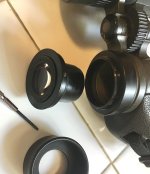Hi all,
Do you have any experience with cleaning the inside of the eyepiece when you can't open it? More specifically, the issue is that there is an object in the left eyepiece of my Nikon SE 10x42 (presumably a dead insect or similar) that can be seen as a dark dot when looking against a homogeneous background (such as clouds).
I have sent the binoculars to two different Nikon service points, but both do not want to risk opening the eyepiece, as it could be irreparably damaged.
The question now is whether it would be possible to non-invasively maneuver the object out of the optical path so that it is at the edge and no longer interferes. Do you have any suggestions or experience what could be done? With heat, cold, electricity, microwaves, ultrasound, etc.? Some of this may sound crazy, but what could I try without too much risk?
Thanks for any suggestions!
Markus
Do you have any experience with cleaning the inside of the eyepiece when you can't open it? More specifically, the issue is that there is an object in the left eyepiece of my Nikon SE 10x42 (presumably a dead insect or similar) that can be seen as a dark dot when looking against a homogeneous background (such as clouds).
I have sent the binoculars to two different Nikon service points, but both do not want to risk opening the eyepiece, as it could be irreparably damaged.
The question now is whether it would be possible to non-invasively maneuver the object out of the optical path so that it is at the edge and no longer interferes. Do you have any suggestions or experience what could be done? With heat, cold, electricity, microwaves, ultrasound, etc.? Some of this may sound crazy, but what could I try without too much risk?
Thanks for any suggestions!
Markus








